

If you’ve been following IBM’s Watson project and like food, you may have noticed growing excitement among chefs, gourmands and molecular gastronomists about one aspect of its development.
The main Watson project is an artificial intelligence that engineers have built to answer questions in native language–that is, questions phrased the way people normally talk, not in the stilted way a search engine like Google understands them. And so far, it’s worked: Watson has been helping nurses and doctors diagnose illnesses, and it’s also managed a major “Jeopardy!” win.
Now, Chef Watson–developed alongside Bon Appetit magazine and several of the world’s finest flavor-profilers–has been launched in beta, enabling you to mash recipes according to ingredients of your own choosing and receive taste-matching advice which, reportedly, can’t fail. While some of the world’s foremost tech luminaries and conspiracy theorists are a bit skeptical about the wiseness of AI, if it’s going to be used at all, allowing it to tell you what to make out of a fridge full of unloved leftovers seems like an inoffensive enough place to start.
I decided to put it to the test. While employed as a food writer for well over a decade, I’ve also spent a good part of the last nine years working on and off in kitchens. Figuring out how to use “spare” ingredients has become quite commonplace in my professional life. I’ve also developed a healthy disregard for recipes as anything other than sources of inspiration (or annoyance) but for the purposes of this experiment am willing to follow along and try any ingredient at least once.
So, with this in mind, I’m going to let Watson tell me what to eat for a week. I’ve spent a good amount of time playing around with the app, which can be found here, and I’m going to follow its instructions to the letter where possible. I have an audience of willing testers for the food and intend to do my best in recreating its recipes on the plate. Still, I’m going to try to test it a bit.
I want to see whether or not it can save me time in the kitchen; also, whether it has any amazing suggestions for dazzling taste matches; if it can help me use things up in the fridge; and whether or not it’s going to try to get me to buy a load of stuff I don’t really need. A lot of work has gone into the creation of this app–and a lot of expertise. But is it useable? Can human beings understand its recipes? Will we want to eat them? Let’s find out.
A disclaimer before we start: Chef Watson isn’t great at telling you when stuff is actually ready and cooked. You need to use your common sense. Take all of its advice as advice and inspiration only. It’s the flavors that really count.

Monday: The Tailgating Corn Salmon Sandwich
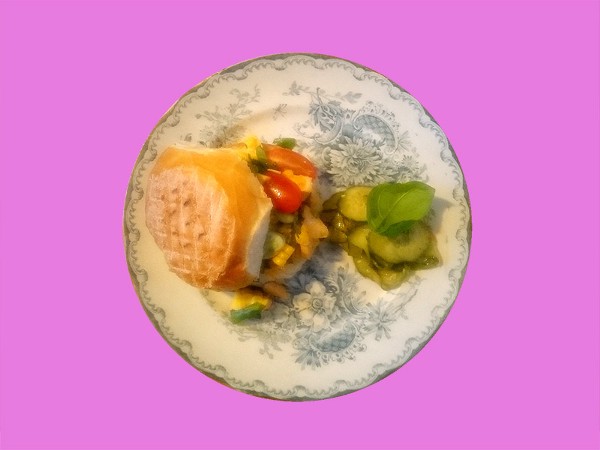
My first impression is that the app is intuitive and pretty simple to use. Once you’ve added an ingredient, it suggests a number of flavor matches, types of dishes and “moods” (including some off-the-wall ones like “Mother’s Day”). Choose a few of these options and the actual recipes begin to bunch up on the right of the screen. I selected salmon and corn, then opted for the wildly suggestive “Tailgating corn salmon sandwich.”
The recipe page itself has links to the original Bon Appetit dish that inspired your AI mélange, accompanied by a couple of pictures. There’s a battery of disclaimers stating that Chef Watson really only wants to suggest ideas, rather than tell you what to eat–presumably to stop people who want to try cooking with fiberglass, for example, from launching “no win, no fee” cases.
My own salmon tailgating recipe seemed pretty straightforward.
There are a couple of nice touches on the page, with regard to usability: You can swap out any ingredients that you might not have in stock for others, which Watson will suggest (it seems fond of adding celery root to dishes). For this first attempt I decided to follow Watson’s advice almost to a T. I didn’t have any garlic chile sauce but managed to make a presumably functional analog out of some garlic and chili sauce. The only other change I made involved adding some broad beans, because I like broad beans.
During prep, I employed a nearly unconscious bit of initiative, namely when I cooked the salmon. It’s entirely likely that Watson was, as seemed to be the case, suggesting that I use raw salmon, but it’s Monday night and I’m not in the mood for anything too mind-bending. Team Watson: If I ruined your tailgater with my pig-headed insistence on cooked fish, I’m sorry.
Although I’m not too sorry because, you know, it was actually a really good dish. I was at first unsure–the basil seemed like a bit of an afterthought; I wasn’t sure the lime zest was necessary; and cold salmon salad on a burger bun isn’t really an easy sell. But damn it, I’d make that sandwich again.
It was missing some substance overall. It made enough for two small buns, so I teamed it up with a nice bit of Korean-spiced, pickled cucumber on the side, which worked well. My fellow diner deemed it “fine, if a little uninteresting”–and yes, maybe it could have done with a bit more sharpness and depth, and maybe a little more “a computer told me how to make this” flavor wackiness, but overall: Well done.
Hint! Definitely add broad beans. They totally worked. Now, to mull over what “tailgating” might mean”¦

Tuesday: Spanish Blood Sausage Porridge
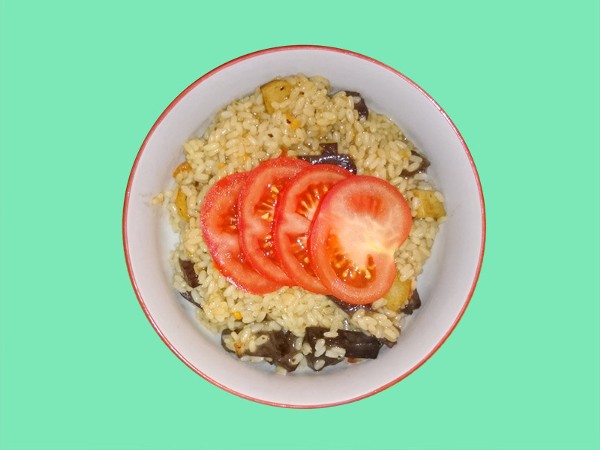
It was day two of the Chef Watson “guest slot” in the kitchen, and things were about to get interesting. Buoyed by yesterday’s Tailgating Salmon Sandwich success, I decided to give Watson something to sink its digital teeth into and supply only one ingredient: blood sausage. I also specified “main” as a style, really so that he/she/it knew that I wasn’t expecting dessert.
If I’m being very honest, I’ve read more appetizing recipes than blood sausage porridge. Even the inclusion of the word “Spanish” doesn’t do anything to fancy it up. And, a bit concerningly, this is a recipe that Watson has extrapolated from one for Rye Porridge with Morels, replacing the rye with rice, the mushroom with sausage and the original’s chicken livers with a single potato and one tomato. Still, maybe it would be brilliant.
But unlike yesterday, I ran into some problems. I wasn’t sure how many tomatoes and potatoes Watson expected me to have here–the ingredients list says one of each; the method suggests many–or also why I had to soak the tomato in boiling water first, although it makes sense in the original mushroom-centric method. Additionally, Waston offered the whimsical instruction to just “cook” the tomatoes and potatoes, presumably for as long as I feel like.
There’s a lot of butter involved in this recipe and rather too much liquid recommended: eight cups of stock for one-and-a-half of rice. I actually got a bit fed up after four and stopped adding them. Forty to 50 minutes cooking time was a bit too long, too–again, that’s been directly extracted from the rye recipe.
But these were mere trifles. The dish tasted great. It’s a lovely blend of flavors and textures, thanks to the blood sausage and the potato. The butter works brilliantly and the tomato on top is a nice touch. And it proves Watson’s functionality. You can suggest one ingredient that you find in the fridge, use your initiative a bit and you’ll be left with something lovely. And buttery. Lovely and buttery.
Well done, Watson!

Wednesday: Diner Cod Pizza
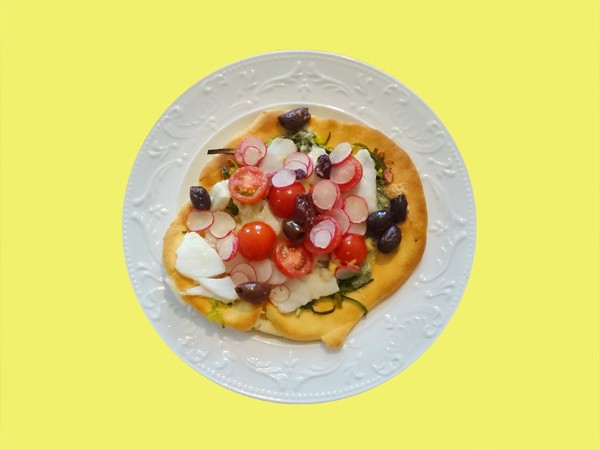
When I read this recipe, I wondered whether this was going to be it for me and Watson. “Diner,” “cod” and “pizza” are three words that don’t really belong together, and the ingredients list seemed more like a supermarket sweep than a recipe. Now that I’ve actually made the meal, I don’t know what to think about anything.
You might remember a classic 1978 George A. Romero-directed horror film called Dawn of the Dead. Its 2004 remake, following the paradigm shift to running zombies in 28 Days Later, suffered critically. My impression of this remake was always that if it’d just been called something different–Zombies Go Shopping, for instance–every single person who saw it would have loved it. As it was, viewers thought it seemed unauthentic, and it gathered what was essentially some unfair criticism. (See also the recent RoboCop remake or, as I call it, CyberSwede vs. Detroit.)
This meal is my culinary Dawn of the Dead. If only Watson had called it something other than pizza, it would have been utterly perfect. It emphatically isn’t a pizza. It has as much in common with pizza as cake does. But there’s something about radishes, cod, ginger, olives, tomatoes and green onions on a pizza crust that just work remarkably well.
To be clear, I fully expected to throw this meal away. I had the website for curry delivery already open on my phone. That’s all before I ate two of the pizzas. They taste like nothing on earth. The addition of Comté cheese and chives is the sort of genius/absurdity that makes people into millionaires. I was, however, nervous to give one to my pregnant fiancée; the ingredients are so weird that I was just sure she’d suffer some really strange psychic reaction or that the baby would grow up to be extremely contrary.
Be careful with this recipe preparation: As I’ve found with Watson, it doesn’t tell you how to assure that your fish is cooked; nor does it tell you how long to pre-bake the crust base. These kinds of things are really important. You need to make sure this dish is cooked properly. It takes longer than you might expect.
I’m writing this from Sweden, the home of the ridiculous “pizza,” and yet I have a feeling that if I were to show this recipe to a chef who ordinarily thinks nothing of piling a kilo of kebab meat and Béarnaise sauce on bread and serving it in a cardboard box with a side salad of fermented cabbage, he or she would balk and tell me that I’ve gone too far. Which would be his or her loss. I think I’m going to have to take this to “Dragon’s Den” instead.
Watson, I don’t know how I’m going to cope with normal recipes after our little holiday together. You’re changing the way I think about food.

Thursday: Fall Celery Sour Cream Parsley Lemon Taco
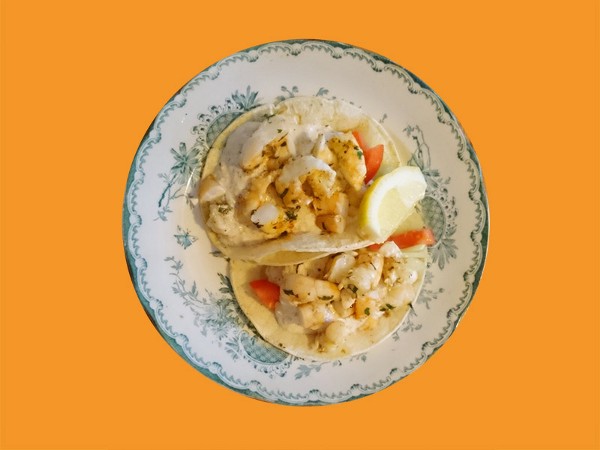
Following yesterday’s culinary epiphany, I was keen to keep a cool head and a critical eye on Chef Watson, so I decided to road-test one theory from an article I found on the internet. It mentioned that some of the most frequently discarded items in American fridges are celery, sour cream, fresh herbs and lemons. Let’s not dwell too much on the “luxury problems” aspect of this (I can’t imagine that people everywhere in the world are lamenting the amount of sour cream and flat-leaf parsley they toss) and focus instead on what Watson can do with this admittedly tricky-sounding shopping list.
What it did was this: Immediately add shrimp, tortillas and salsa verde. The salsa verde it recommended, from an un-Watsoned recipe courtesy of Bon Appetit, was fantastic. It’s nothing like the salsa verde I know and love, with its capers and dill pickles and anchovies–this iteration required a bit of a simmer, was super-spicy and delicious. (I had to cheat and use normal tomatoes instead of tomatillos, but I don’t think it made a huge difference.)
The marinade for the shrimp was unusual in that like a lot of what Watson recommends it used a ton of butter. A hefty wallop of our old friend kosher salt, too. Now, I’ve worked as a chef on and off for several years so am unfazed by the appearance of salt and butter in recipes. They’re how you make things taste nice. However, there’s no getting away from the fact that I bought a stick of butter at the start of the week and it’s already gone.
The assembled tacos were good–they were uncontroversial. My dining companion deemed the salsa “a bit too spicy,” but I liked the kick it gave the dish and the sour cream calmed it down a bit. It struck me as a bit of a shame to fire up the barbecue for only about two minutes’ worth of cooking time, but it’s May and the sun is shining so what the heck.
Was this recipe as absurd as yesterday’s? Absolutely not. Was it as memorable? Sadly, I don’t think so. Would I make it again? I’m sorry, Watson, but probably not. These tacos were good but ultimately not worth the prep hassle.

Friday: Mexican Mushroom Lasagna
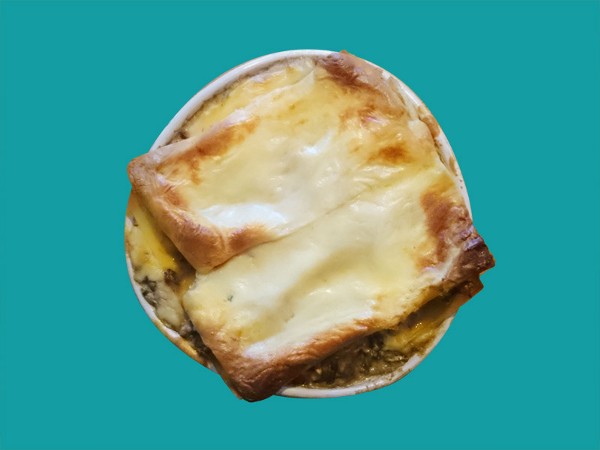
Before I start, I don’t want you to get the impression that my love affair (which reached the height of its passion on Wednesday) with Watson is over. It absolutely isn’t. I have been consistently impressed with the software’s intelligence, its ease of use and the audacity of some of its suggestions. For flavor-matching, it’s incredible. It really works. It probably won’t save you any money; it won’t make you thin; and it won’t teach you how to actually cook–all of that stuff you have to work out for yourself. But, at this stage, it’s a distinctly impressive and worthwhile project. Do give it a go.
But”¦ be prepared to have to coax something workable out of it every once in a while. Today, it took me a long time to find a meat-free recipe which didn’t, when it came down to it, contain some sort of meat. I selected “meat” as an option for what I didn’t want to include, and it took me to a recipe for sausage lasagne. With one-and-a-half pounds of sausage in it. I removed the sausage, and it replaced it with turkey mince. Maybe someone just needs to tell Watson that neither sausages nor turkeys grow on trees.
After much tinkering and submitting and resubmitting, the recipe I ended up with is for lasagne topped with a sort of creamy mashed potato sauce. It’s very easy and it’s a profoundly smart use of ingredients. The lasagne is not the world’s most aesthetically appealing dish, and it’s not as astonishingly flavored as some of this week’s other revelations, but I don’t think I’ll be making my cheese sauce in any other way from this point onwards. Top marks.
And, in essence, this kind of sums up Watson for me. You need to tinker with it a bit before you can find something usable. You may need to make a “do I want to put mashed potato on this lasagne?” leap of faith, and you’re going to have to actually go with it if you want the app’s full benefit. You’ll consume a lot of dairy products, and you might find yourself daydreaming about nice, simple, unadorned salads if you decide to go all-in with its suggestions.
But an AI that can tell us how to make a pizza out of cod, ginger and radishes that you know is going to taste amazing? One that will gladly suggest a workable recipe for blood sausage porridge and walk you through it without too much hassle? That gives you a “how crazy” option for each ingredient? That is only designed to make the lives of food enthusiasts more interesting? Why on earth not? Watson and I are going to be good friends from this point forward, even if we don’t speak every day. And I can’t wait to introduce it to others.
Now, though, I’m going to only consume smoothies for a week. Seriously, if I even look at butter in the next few days, I’m probably going to puke.


How We Get To Next was a magazine that explored the future of science, technology, and culture from 2014 to 2019. This article is part of our The Future of Food section, which covers new innovations changing everything from farming to cooking. Click the logo to read more.
